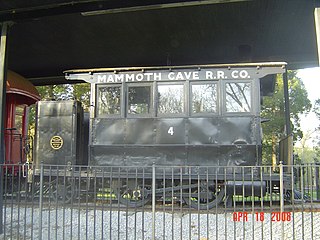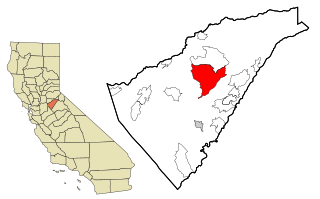
Mammoth Cave National Park is an American national park in central Kentucky, encompassing portions of Mammoth Cave, the longest cave system known in the world. Since the 1972 unification of Mammoth Cave with the even-longer system under Flint Ridge to the north, the official name of the system has been the Mammoth–Flint Ridge Cave System. The park was established as a national park on July 1, 1941, a World Heritage Site on October 27, 1981, and an international Biosphere Reserve on September 26, 1990.

Barren County is a county located in the U.S. state of Kentucky. As of the 2010 census, the population was 42,173. Its county seat is Glasgow. The county was founded on December 20, 1798, from parts of Warren and Green Counties. It was named for the Barrens, meadow lands that cover the northern third, though actually the soil is fertile.

Mammoth Lakes is a town in Mono County, California, the county's only incorporated community. It is located 9 miles (14 km) northwest of Mount Morrison, at an elevation of 7,880 feet (2,400 m). As of the 2010 United States Census, the population was 8,234, reflecting a 16% increase from the 2000 Census.

Cave City is a home rule-class city in Barren County, Kentucky, in the United States. The population was 2,240 at the 2010 census. It is part of the Glasgow Micropolitan Statistical Area.

Park City is a home rule-class city in Barren County, Kentucky, United States. The population was 537 at the 2010 census. It has historically served as a gateway to nearby Mammoth Cave National Park and to Diamond Caverns, a privately owned cave attraction.

Devils Postpile National Monument is a National Monument located near Mammoth Mountain in eastern California. The monument protects Devils Postpile, an unusual rock formation of columnar basalt. It encompasses 798 acres (323 ha) and includes two main tourist attractions: the Devils Postpile formation and Rainbow Falls, a waterfall on the Middle Fork of the San Joaquin River. In addition, the John Muir Trail and Pacific Crest Trail merge into one trail as they pass through the monument. Excluding a small developed area containing the monument headquarters, visitor center and a campground; the National Monument lies within the borders of the Ansel Adams Wilderness.

Dwarf elephants are prehistoric members of the order Proboscidea which, through the process of allopatric speciation on islands, evolved much smaller body sizes in comparison with their immediate ancestors. Dwarf elephants are an example of insular dwarfism, the phenomenon whereby large terrestrial vertebrates that colonize islands evolve dwarf forms, a phenomenon attributed to adaptation to resource-poor environments and selection for early maturation and reproduction. Some modern populations of Asian elephants have also undergone size reduction on islands to a lesser degree, resulting in populations of pygmy elephants.
William Floyd Collins, better known as Floyd Collins, was an American cave explorer, principally in a region of Central Kentucky that houses hundreds of miles of interconnected caverns within Mammoth Cave National Park, the longest cave system in the world. In the early 20th century, in an era known as the Kentucky Cave Wars, commercial cave owners and explorers in Kentucky entered into a bitter competition to exploit the bounty of caves for commercial profit from tourists, who paid to see the caves. On January 30, 1925, while trying to find a new entrance to Crystal Cave, Collins became trapped in a narrow crawlway, 55 feet (17 m) below ground. The rescue operation to save Collins became a national newspaper sensation and one of the first major news stories to be reported using the new technology of broadcast radio. The rescue attempt grew to become the third-biggest media event between the world wars.
The Cave Research Foundation (CRF) is an American private, non-profit group dedicated to the exploration, research, and conservation of caves. The group arose in the early 1950s from the exploration efforts at Floyd Collins Crystal Cave, now within Mammoth Cave National Park. Its stated goals were: to promote exploration and documentation of caves and karst areas, initiate and support cave and karst research, aid in cave conservation and protection, and to assist with the interpretation of caves and karst to the public.

The Columbian mammoth is an extinct species of mammoth that inhabited North America as far north as the northern United States and as far south as Costa Rica during the Pleistocene epoch. It was one of the last in a line of mammoth species, beginning with Mammuthus subplanifrons in the early Pliocene. The Columbian mammoth evolved from the steppe mammoth, which entered North America from Asia about 1.5 million years ago. The pygmy mammoths of the Channel Islands of California evolved from Columbian mammoths. The closest extant relative of the Columbian and other mammoths is the Asian elephant.

California Cavern is a Limestone cave in the Sierra Nevada foothills, in Cave City, Calaveras County, California.
A Mammoth is an extinct mammal and close relative to the modern elephant.

Mammoth Cave Railroad was a short rail line with a small train off the Louisville and Nashville Railroad (L&N) that went to Mammoth Caves in Kentucky. The tiny 9-mile (14 km) railroad from Glasgow Junction to Mammoth Caves was started in 1886 and operated for 45 years. The complete Dinkey Train consisted only of a "dummy" 0-4-2T type steam locomotive and a wooden coach to carry passengers and their luggage. Among the many stops on the way to Mammoth Caves were Diamond Caverns, Grand Avenue Cave, Procter Cave and Hotel, Chaumont Post Office, Union City, Sloan's Crossing, and Ganter's Hotel. The Dinkey Train could obtain speeds of 25–35 miles per hour on the lightweight rails.

The woolly mammoth is an extinct species of mammoth that lived during the Pleistocene until its extinction in the early Holocene epoch. It was one of the last in a line of mammoth species, beginning with Mammuthus subplanifrons in the early Pliocene. The woolly mammoth diverged from the steppe mammoth about 400,000 years ago in East Asia. Its closest extant relative is the Asian elephant. The appearance and behaviour of this species are among the best studied of any prehistoric animal because of the discovery of frozen carcasses in Siberia and Alaska, as well as skeletons, teeth, stomach contents, dung, and depiction from life in prehistoric cave paintings. Mammoth remains had long been known in Asia before they became known to Europeans in the 17th century. The origin of these remains was long a matter of debate, and often explained as being remains of legendary creatures. The mammoth was identified as an extinct species of elephant by Georges Cuvier in 1796.
Mammoth Cave is a National Park in Kentucky, USA.

The Rouffignac cave, in the French commune of Rouffignac-Saint-Cernin-de-Reilhac in the Dordogne département, contains over 250 engravings and cave paintings dating back to the Upper Paleolithic.

Mammoth Cave is a large limestone cave 21 km (13 mi) south of the town of Margaret River in south-western Western Australia, and about 300 km (190 mi) south of Perth. It lies within the Leeuwin-Naturaliste National Park and is surrounded by Karri and Marri forest. It has also had extinct animal fossils found in Mammoth Cave.

The Vogelherd Cave is located in the eastern Swabian Jura, south-western Germany. This limestone karst cave came to scientific and public attention after the 1931 discovery of the Upper Palaeolithic Vogelherd figurines, attributed to paleo-humans of the Aurignacian culture. These miniature sculptures made of mammoth ivory rank among the oldest uncontested works of art of mankind. In 2017 the site became part of the UNESCO World Heritage Site "Caves and Ice Age Art in the Swabian Jura".

Pešturina is a cave in the municipality of Niška Banja in southeast Serbia. It is southwest of Jelašnica and 20 km (12 mi) southeast of Niš. Artifacts from the Middle and Upper Paleolithic periods were discovered since the archaeological excavations began in 2006. The remains, identified as the Mousterian culture, were dated from 102,000 BP+ 5,000 to 39,000 BP + 3,000, which makes Pešturina one of the latest surviving Neanderthal habitats. The cave has been nicknamed the "Serbian Atapuerca".


















